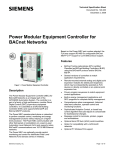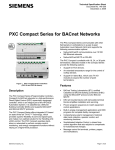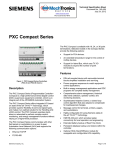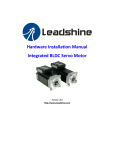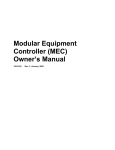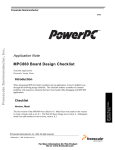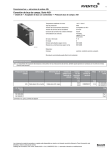Download Product Datasheet
Transcript
Technical Specification Sheet Document No. 149-203 Rev. 2, July 20, 2008 Power Modular Equipment Controller for BACnet Networks MEC part number selection, the FLN may support RS-485 for configurable BACnet MS/TP or P1 support, or, LonTalk® protocol support. Features • BACnet Building Controller (B-BC) using BACnet/IP protocol • Several versions of controllers to match application requirements • Remote mounted external analog and digital point expansion modules for added point expansion which may be independently operated as FLN devices or directly controlled on an optional point expansion bus • Proven program sequences to match equipment control applications • Sophisticated Adaptive Control, a closed loop control algorithm that auto-adjusts to compensate for load/seasonal changes Built-in energy management applications and DDC programs for complete facility management Figure 1. Power Modular Equipment Controller. Description The Power Modular Equipment Controller for BACnet® Networks is an integral part of the APOGEE® Automation System. The controller is a part of a family of high performance, modular Direct Digital Control (DDC) supervisory equipment controllers. The controller is classified as a BACnet Building Controller (B-BC) and utilizes the BACnet/IP protocol. The controller operates stand-alone or networked to perform complex control, monitoring and energy management functions without relying on a higher-level processor. The Power MEC communicates with other field panels or workstations on a peer-to-peer Automation Level Network (ALN). The ALN supports the BACnet/IP protocol over 10/100 MB Ethernet networks. The Power MEC can optionally provide central monitoring and control for distributed Field Level Network (FLN) devices (wired or wireless). Via Power Siemens Building Technologies, Inc. • • Comprehensive alarm management, historical data trend collection, operator control and monitoring functions • Message control for terminals, printers, pagers and workstations • Option with Hand Off Auto (HOA) switches • Option for compatibility with LonWorks® networks • Wireless FLN support Page 1 of 11 DIGITAL INPUT CONNECTORS HOA CONTROL SWITCHES C 57 DO25 NO 58 NC 59 C 60 DO26 NO 61 NC 62 0A C 63 DO27 NO 64 NC 65 0A C 66 A DO28 NO 67 NC 68 0A C 69 A DO29 NO 70 NC 71 0A C 72 DO30 NO 73 0A NC 74 C 75 DO31 NO 76 0 NC 77 A C 78 DO32 NO 79 NC 80 0 DI1 21 DI2 43 DI3 65 HOA LED DI4 87 9 10 DI5 11 12 DI6 13 14 DI7 15 16 DI8 A ANALOG OUTPUT CONNECTORS A 25 + 17 + AO13 26 AO9 18 27 A+ 19 + AO14 28 AO10 20 29 + 21 + AO15 30 AAO11 22 31 + 23 + AO16 32 AO12 24 - 24 VDC SENSOR POWER SHIELD TERMINATION A A 0A DIGITAL OUTPUT CONNECTORS 24 VAC POWER CONNECTOR 53 + 24 VDC 54 55 SENSOR 56 SUPPLY 49 50 51 52 SHIELD AI21 4241-+ 33 + 34 AI22 4443-+ 35 + 36 AI23 4645-+ 37 + 38 AI24 4847-+ 39 + AI20 40 FLN FLN FLN BLN 5 4 3 2 1 ANALOG INPUT CONNECTORS FLN CONNECTORS (3) AI17 AI18 LNK/A CT 100 TX FULL /CO L RX TX RX RX TX ENET EXP MO DE M STAT US BATT TX RX TX RX TX RX RX RS 422 AI19 EXPANSION BUS CONNECTOR (EXP) ETHERNET PORT MEC0103R1 MMI PORT STATUS LEDS BATTERY COVER Figure 2. Power Modular Equipment Controller components and key features. Hardware Controllers Several styles of controllers provide flexibility and expansion to meet application needs. All the Power MEC “EB” and ‘EBx” versions support industry standard BACnet/IP networks through a direct connection to 10/100 Base-T for ALN communications. Power MEC Controller – 11xxEB In addition to building and system management functions, this controller provides control of the 32 points contained on the input/output point board. Power MEC Controller– 12xxEB In addition to control of the 32 points on the input/output point board, this controller supports analog and digital point expansion modules, which can be mounted remote from the controller. This capability expands the point capacity of the Power MEC and provides for cost-effective placement of the point terminations close to the load. Power MEC Controller – 12xxEFB The Power MEC “EFB” version adds three connections to the APOGEE FLN, for a total of 96 devices supervised by the Power MEC, or it may be configured for a single BACnet MS/TP connection supporting up to 96 devices. Power MEC Controller – 12xxELB The Power MEC “ELB” version adds LonWorks compatibility at the FLN. It is equipped with a Neuron Microprocessor and FTT-10A Transceiver. Instead of three connections to the APOGEE FLN, it has a single connection for a LonWorks network. The “ELB” versions have a LonWorks network database server embedded. This database maintains Page 2 of 11 a dynamic, real-time representation of the LonWorks network including connections/bindings, node status, and configuration parameters values. The Power MEC consists of the following three major components: the Input/Output Point Board, the Power Supply, and the Controller Board. • Input/Output Point Board The input/output point board contains 32 points that perform A/D or D/A conversion, signal processing, point command output and communication with the controller board. The terminal blocks are removable for easy termination of field wiring. The analog input points are selectable to be 0-10V, 4-20 mA, 1K RTD or optional 100K Thermistor. The analog output points are also selectable to be either 0-10V or 4-20 mA. The digital inputs are dry contact, with four being pulse accumulator inputs. The digital outputs support 110/220V Form C rated relays. • Power Supply The power supply provides regulated power to the input/output point board and active sensors. The power supply is internal to the Power MEC housing, simplifying installation and troubleshooting. The power supply works with the controller board to ensure smooth power up and down sequences for the equipment controlled by the I/O point board and analog and digital point blocks, even through brownout conditions. Status LEDs indicate 24 Vac supplied from the power supply and 24 Vdc supplied to the input/output point board. • Controller Board The controller board is a microprocessor-based multitasking platform for program execution and communications with the I/O point board and with other Power MECs and field panels over the ALN. The 12xx controllers can also support analog or digital point expansion modules, which provide for point expansion capability to match the application requirements. The controller board scans field data, optimizes control parameters and manages operator requests for data. An RS-232 operator terminal port with a quick connect phone jack (RJ-11) is included with each controller board for operator devices such as a Local User Interface (LUI), simple CRT terminal, laptop PC, or printer. In addition, the MEC 13xx controller supports an RS-232 quick connect phone jack (RJ45) for use with a phone modem for APOGEE autodial stand-alone network capability. Siemens Building Technologies, Inc. The 12xxEFB controllers support 3 FLN trunks for communications with a total of 96 FLN devices, or one BACnet MS/TP trunk supporting up to 96 devices. The 12xxELB controllers support 1 FLN trunk for communications with a maximum of 126 LonWorks devices. The program and database information stored in the Power MEC RAM memory is battery-backed. This eliminates the need for time-consuming program and database re-entry in the event of an extended power failure. When battery replacement is necessary, the controller board illuminates a “battery low” status LED and can send an alarm message to selected printers or terminals. The firmware, including the operating system, is stored in non-volatile flash ROM memory, allowing for ease of upgrade at the job site if a new firmware update is made available by simply flashing the ROM. Brownout protection and power recovery circuitry protect the controller board from power fluctuations. PX Series Enclosure Assemblies PX series enclosures house both electronic and pneumatic components. The enclosures include a perforated backplane for mounting of the PXC series controllers, Power Modular Equipment Controllers, Point Expansion Modules or other electronic or pneumatic components. Two sizes are available (19” and 34”) that can house the Power MEC: • 19” enclosure, hinged door and key lock • 34” enclosure, hinged door and key lock • 18" enclosure, pull-box type utility cabinet (for accessories, not for MEC) The enclosures are constructed of metal to accommodate secure conduit fittings and protect components against electrical transients. The enclosure allows space for easy wire routing and terminations. Service Box Service boxes are available for mounting in the 19” or 34” enclosures. Models provide step down power from either 115 Vac or 230 Vac to 24 Vac and offer protection against electrical transients. The service boxes are sized in various power ratings to provide one or two Class 1 Power Limited terminations for use inside the enclosure to power controllers and I/O modules, and one Class 2 termination for use outside the enclosure to power remote devices. The 115 Vac versions provide two 115 Vac outlets for accessory devices such as modems and laptops. Optional sidewall kits are available for service box installation in other NEMA Type 1 or better enclosures such as motor control cabinets. Siemens Building Technologies, Inc. Figure 3. PX Series Enclosure Assemblies. Analog and Digital Point Expansion Modules In addition to the points on the input/output board, the 12xx Power MECs support analog and digital Point Expansion Modules. The controller can support a maximum of any combination of eight modules. They can be mounted next to or remote from the controller depending upon the job requirements. The total length of the wiring run for Point Expansion Modules is a maximum of 200 feet (61 meters) on the MEC expansion bus. Point Expansion Modules are also compatible with the APOGEE P1 FLN. Point Expansion Module details are: • Analog Point Expansion Module – 4AI, 4AO • Analog Point Expansion Module – 8AI • Digital Point Expansion Module – 4DI, 4DO • Digital Point Expansion Module – 8DI, 4DO The analog input points are user selectable to be 010V, 4-20 mA, 1K RTD or optional 100K Thermistor input. The analog output points are also user configurable to be 0-10V or 0-20 mA. The digital inputs are dry contact with four of the inputs being pulse accumulator points. The relayed digital output points support 110/220V Form C relays. Figure 4. Analog and Digital Point Expansion Modules. Page 3 of 11 Modular Equipment Control with Application Flexibility Built-in Direct Digital Control Routines The Power MECs are high performance controllers with complete flexibility to allow the owner to customize each controller with the exact program for the application. In addition, each controller can be sized to meet the hardware requirements for the application. The Power MEC provides stand-alone Direct Digital Control (DDC) to deliver precise HVAC control and comprehensive information about system operation. The controller receives information from sensors in the building, processes the information, and directly controls the equipment. The following functions are available: The control program for each panel is customized to exactly match the application. Proven Powers Process Control Language (PPCL), a BASIC type programming language provides direct digital control and energy management sequences to control equipment precisely and optimize energy usage. Menu Prompted, English Language Operator Interface The Power MEC has a simple, yet powerful menu driven English Language Operator Interface that provides, among other things: • Point monitoring and display, • Point commanding, • Historical trend collection and display for multiple points, • Event scheduling, • Program editing and modification via Powers Process Control Language (PPCL), • Alarm reporting and acknowledgment, and • Continual display of dynamic information. Global Information Access Each Power MEC is equipped with one RS-232 operator terminal port. This port supports the connection of a Local User Interface (LUI), simple CRT terminal, laptop PC, or printer. Devices connected to the terminal port gain global information access. • Adaptive control, auto adjusting closed loop control, provides more efficient, adaptive, robust, fast, and stable control than the traditional PID control algorithm. Superior in terms of response time, holding steady state, and minimizing error, oscillations and actuator repositioning. • Closed Loop Proportional, Integral and Derivative (PID) control • Logical sequencing, • Alarm detection and reporting, and • Reset schedules. Built-in Energy Management Applications The following applications are programmed in the Power MEC and require simple parameter input for implementation: • Peak demand limiting • Start-Stop time optimization • Equipment scheduling, optimization and sequencing • Temperature compensated duty cycling • Economizer control • Night setback control • Automatic Daylight Savings Time switchover • Temporary schedule override • Holiday scheduling, Calendar-based scheduling, and Event scheduling Multiple Operator Access Multiple operators can access the network simultaneously. Multiple operator access ensures that alarms are reported to an alarm printer while an operator accesses information from a local terminal. When using the Ethernet ALN option, multiple operators may also access the controller through concurrent Telnet sessions and/or local operator terminal ports. Page 4 of 11 Siemens Building Technologies, Inc. Specifications Processor Motorola MPC - 1xxxEB, 1xxxEFB, 1xxxELB Processor Clock Speed Memory Battery Backup of RAM (field Replaceable) AA Alkaline Network Communication: Automation Level Network 860T 48 MHz 64 MB RAM/8mb FLASH (72 MB Total) 14 days typical 10/100 Base-T for BACnet/IP ALN Field Level Network 38.4 Kbps for LonWorks FLN P1 FLN or BACnet MS/TP FLN: 9600, 19200, 38400 Point Expansion Bus 38.4 Kbps 12 bits 8 bits RS-232 port A/D Resolution (analog in) D/A Resolution (analog out) Local Communication Interface Voltage Requirements Service Box, 115V Service Box, 230V Controller or Expansion Module Power Consumption Power Modular Equipment Controllers Analog Point Expansion module 8AI Analog Point Expansion module 4AI/4AO Digital Point Expansion module 8DI/4DO Digital Point Expansion module 4DI/4DO Enclosure Type Ambient Operating Environment Agency Listings Agency Compliance 115 Vac +/- 15% @ 60 Hz +/- 5% 230 Vac +/- 15% @ 50/60 Hz +/- 5% 20 Vac to 30 Vac @ 47 Hz to 63 Hz 50 VA 17 VA @ 24 Vac 14 VA @ 24 Vac 20 VA @ 24 Vac 17 VA @ 24 Vac NEMA 1 +32°F to +120°F (0°C to +49°C) 93% RH (Non-condensing) UL 864 UUKL ULC-C100 UUKL7 UL 916 PAZX FCC Compliance Australian EMC Framework European EMC Directive (CE) European Low Voltage Directive (LVD) Dimensions: Modular Equipment Controller Analog Point Expansion Module Digital Point Expansion Module NEMA Type 1 Enclosures: 18” Utility Cabinet Enclosure 19” Enclosure 34” Enclosure Mounting Surface Siemens Building Technologies, Inc. 11.4" H × 9.5" W × 3.75" D (289 mm × 241 mm × 95 mm) 6" H × 9.5" W × 3.75" D (152 mm × 241 mm × 95mm) 6" H × 9.5" W × 3.75" D (152 mm × 241mm × 95mm) 18" H × 14" W × 6" D (457.2 mm × 356.6 mm × 152.4 mm) 19" H × 22" W × 5.75" D (482.6 mm × 558.8 mm × 146.1 mm) 34" H × 22" W × 5.75" D (863.6 mm × 558.8 mm × 146.1 mm) Building Wall or Structural Member Page 5 of 11 Ordering Information Controller Range Description Product Number Power BACnet MEC 1100 EB, 8DI, 8DO, 8AI, 8AO, HOA-ready, BACnet/IP Ethernet ALN Power BACnet MEC 1110 EB, 8DI, 8DO, 8AI, 8AO, with HOA, BACnet/IP Ethernet ALN 549-630 549-631 Power BACnet MEC 1200 EB, 8DI, 8DO, 8AI, 8AO, point expansion support, HOA-ready, BACnet/IP Ethernet ALN Power BACnet MEC 1210 EB, 8DI, 8DO, 8AI, 8AO, point expansion support, with HOA, BACnet/IP Ethernet ALN 549-632 549-633 Power BACnet MEC 1200 EFB, 8DI, 8DO, 8AI, 8AO, point expansion support, RS-485 FLN support, HOA-ready, BACnet/IP Ethernet ALN Power BACnet MEC 1210 EFB, 8DI, 8DO, 8AI, 8AO, point expansion support, RS-485 FLN support, with HOA, BACnet/IP Ethernet ALN 549-634 Power BACnet MEC 1200 ELB, 8DI, 8DO, 8AI, 8AO, point expansion support, LonWorks network, HOA-ready, BACnet/IP Ethernet ALN Power BACnet MEC 1210 ELB, 8DI, 8DO, 8AI, 8AO, point expansion support, LonWorks network, with HOA, BACnet/IP Ethernet ALN 549-636 549-635 549-637 Point Expansion Modules Analog Point Expansion Module, 4AI/4AO 24V HOA-ready - for MEC Expansion or FLN 549-214 Analog Point Expansion Module, 4AI/4AO 24V with HOA - for MEC Expansion or FLN 549-215 Digital Point Expansion Module, 4DI/4DO 24V HOA-ready - for MEC Expansion or FLN 549-212 Digital Point Expansion Module, 4DI/4DO 24V with HOA - for MEC Expansion or FLN 549-213 Analog Point Expansion Module, 8AI 24V – for MEC Expansion or FLN 549-209 Digital Point Expansion Module, 8DI/4DO 24V HOA-ready – for MEC Expansion or FLN 549-210 Digital Point Expansion Module, 8DI/4DO 24V with HOA – for MEC Expansion or FLN 549-211 Service Boxes and Enclosures Service Box, 115V to 24 Vac – until existing stock is depleted Service Box, 230V to 24 Vac – until existing stock is depleted 549-506 549-507 PX Series Service Box — available by 2009 — 115V, 24 Vac, 50/60 Hz, 192 VA PXA-SB115V192VA PX Series Service Box — available by 2009 — 115V, 24 Vac, 50/60 Hz, 384 VA PXA-SB115V384VA PX Series Service Box — available by 2009 — 230V, 24 Vac, 50/60 Hz, 192 VA PXA-SB230V192VA PX Series Service Box — available by 2009 — 230V, 24 Vac, 50/60 Hz, 384 VA PXA-SB230V384VA 18" Enclosure (Utility Cabinet) (UL Listed NEMA Type 1 Enclosure) PXA-ENC18 19” Enclosure (UL Listed NEMA Type 1 Enclosure) PXA-ENC19 34” Enclosure (UL Listed NEMA Type 1 Enclosure) PXA-ENC34 HOA Upgrade-Kits Description Product Number HOA Upgrade Kit Analog Point Block 4AI/4AO 549-520 HOA Upgrade Kit Digital Point Block 4DI/4DO 549-518 HOA Upgrade Kit Digital Point Block 8DI/4DO 549-519 Page 6 of 11 Siemens Building Technologies, Inc. Accessories Description Product Number Modem Cable (DB25 male to RJ-45 8-pin) for hardware flow control of autodial (Dial-up) modem MMI Extension Cable, (RJ-11 male to female) for printers or terminals outside of enclosure MMI Cable (DB9 female to RJ-11 6-pin) for no flow control operator interface connections 549-510 545-712 540-143 Documentation Description Power Modular Equipment Controller Owner’s Manual Powers Process Control Language (PPCL) User’s Manual Siemens Building Technologies, Inc. Document Number 125-2183 125-1896 Page 7 of 11 BACnet Protocol Implementation Conformance Statement Products Product Model Number Protocol Revision Software Version Firmware Version Power BACnet Modular Equipment Controller 1200-EFB 1210-EFB 1200-ELB 1210-ELB 1100-EB 1110-EB 1200-EB 1210-EB 135-2004 N/A 3.1 Vendor Information Siemens Building Technologies 1000 Deerfield Parkway Buffalo Grove, IL 60089 www.sbt.siemens.com Product Description An integral member of the APOGEE product family, the Power MEC for BACnet Networks is a high performance, modular Direct Digital Control (DDC) supervisory equipment and primary building controller. The Power MEC operates stand-alone or networked to perform complex control, monitoring and energy management functions without relying on a higher-level processor. The Power MEC communicates on a 10/100 MB Ethernet BACnet/IP network. It can optionally provide central monitoring and control for distributed Field Level Network (FLN) devices. BACnet Standardized Device Profile (Annex L) Supported Device Profile BACnet Operator Workstation (B-OWS) • BACnet Building Controller (B-BC) BACnet Advanced Application Controller (B-AAC) BACnet Application Specific Controller (B-ASC) BACnet Smart Actuator (B-SA) BACnet Smart Sensor (B-SS) Page 8 of 11 Siemens Building Technologies, Inc. Supported BACnet Interoperability Building Blocks (BIBBs) BIBB Name Initiate Execute Data Sharing DS-RP-A Data Sharing-ReadProperty-A DS-RP-B Data Sharing-ReadProperty-B DS-RPM-A Data Sharing-ReadPropertyMultiple-A DS-RPM-B Data Sharing-ReadPropertyMultiple-B DS-WP-A Data Sharing-WriteProperty-A DS-WP-B Data Sharing-WriteProperty-B • DS-WPM-B Data Sharing-WritePropertyMultiple-B • DS-COV-A Data Sharing-COV-A DS-COV-B Data Sharing-COV-B DS-COVU-A Data Sharing-COV-Unsolicited-A DS-COVU-B Data Sharing-COV-Unsolicited-B • SCHED-I-B Scheduling-Internal-B • SCHED-E-B Scheduling-External-B • • • • • • • • • Scheduling Alarm and Event Management AE-N-A Alarm and Event-Notification-A AE-N-I-B Alarm and Event-Notification Internal-B AE-ACK-A Alarm and Event-ACK-A AE-ACK-B Alarm and Event-ACK-B • AE-ASUM-B Alarm and Event-Alarm Summary-B • AE-ESUM-A Alarm and Event-Enrollment Summary-A AE-ESUM-B Alarm and Event-Enrollment Summary-B AE-INFO-A Alarm and Event-Information-A AE-INFO-B Alarm and Event-Information-B • • • • • • • Trending T-VMT-A Trending-Viewing and Modifying Trends-A T-VMT-I-B Trending-Viewing and Modifying Trends-Internal-B • T-VMT-E-B Trending-Viewing and Modifying Trends-External-B • T-ATR-B Trending-Automated Trend Retrieval-B • • Network Management NM-CE-A Siemens Building Technologies, Inc. Network Management-Connection Establishment-A • Page 9 of 11 Device Management DM-DDB-A Device Management-Dynamic Device Binding-A DM-DDB-B Device Management-Dynamic Device Binding-B DM-DOB-A Device Management-Dynamic Object Binding-A DM-DOB-B Device Management-Dynamic Object Binding-B • DM-DCC-B Device Management-DeviceCommunicationControl-B • DM-PT-A Device Management-Private Transfer-A DM-PT-B Device Management-Private Transfer-B DM-TM-A Device Management-Text Message-A DM-TM-B Device Management-Text Message-B • DM-TS-B Device Management-TimeSynchronization-B • DM-RD-B Device Management-ReinitializeDevice-B • DM-BR-B Device Management-Backup and Restore-B • DM-LM-B Device Management-List Manipulation-B • DM-OCD-B Device Management-Object Creation and Deletion-B • • • • • • • Standard Object Types Supported Object Type Creatable Deletable Analog Input Analog Output Analog Value Binary Input Binary Output Binary Value Calendar • • Command • • Notification Class • • Schedule • • Device File Multi-state Output Multi-state Value Trend Log Page 10 of 11 Siemens Building Technologies, Inc. Data Link Layer Options • BACnet IP, (Annex J) • BACnet IP, (Annex J), Foreign Device ISO 8802-3, Ethernet (Clause 7) ANSI/ATA 878.1, 2.5 Mb. ARCNET (Clause 8) ANSI/ATA 878.1, RS-485 ARCNET (Clause 8), baud rate(s) ____________ MS/TP master (Clause 9), baud rate(s): 9600 bps, 19200 bps, 38400 bps • MS/TP slave (Clause 9), baud rate(s): Point-To-Point, EIA 232 (Clause 10), baud rate(s): _________________ Point-To-Point, modem, (Clause 10), baud rate(s): _________________ LonTalk, (Clause 11), medium: _________________________________ Other: _____________________________________________________ Segmentation Capability Able to transmit segmented messages Yes Window Size: 32 Able to receive segmented messages Yes Window Size: 32 Device Address Binding Is Static Device Binding supported? Yes Networking Options • Router, Clause 6 BACnet/IP (Annex J) to BACnet MS/TP Annex H.3, BACnet Tunneling Router over UDP/IP • Yes BACnet/IP Broadcast Management Device (BBMD) Does the BBMD support registrations by Foreign Devices? Character Sets • ANSI X3.4 ISO 10646 (UCS-2) IBM™/Microsoft™ DBCS ISO 10646 (ICS-4) ISO 8859-1 JIS C 6226 Information in this document is based on specifications believed correct at the time of publication. The right is reserved to make changes as design improvements are introduced. APOGEE is a registered trademark of Siemens Building Technologies, Inc. BACnet is a registered trademark of the American Society of Heating, Refrigeration and Air-Conditioning Engineers, Inc. LonMark and LonTalk are registered trademarks of Echelon Corporation. © 2008 Siemens Building Technologies, Inc. Siemens Building Technologies, Inc. 1000 Deerfield Parkway Buffalo Grove, IL 60089 Your feedback is important to us. If you have comments about this document, please send them to [email protected]. Document No. 149-203 Country of Origin: U.S. Page 11 of 11











